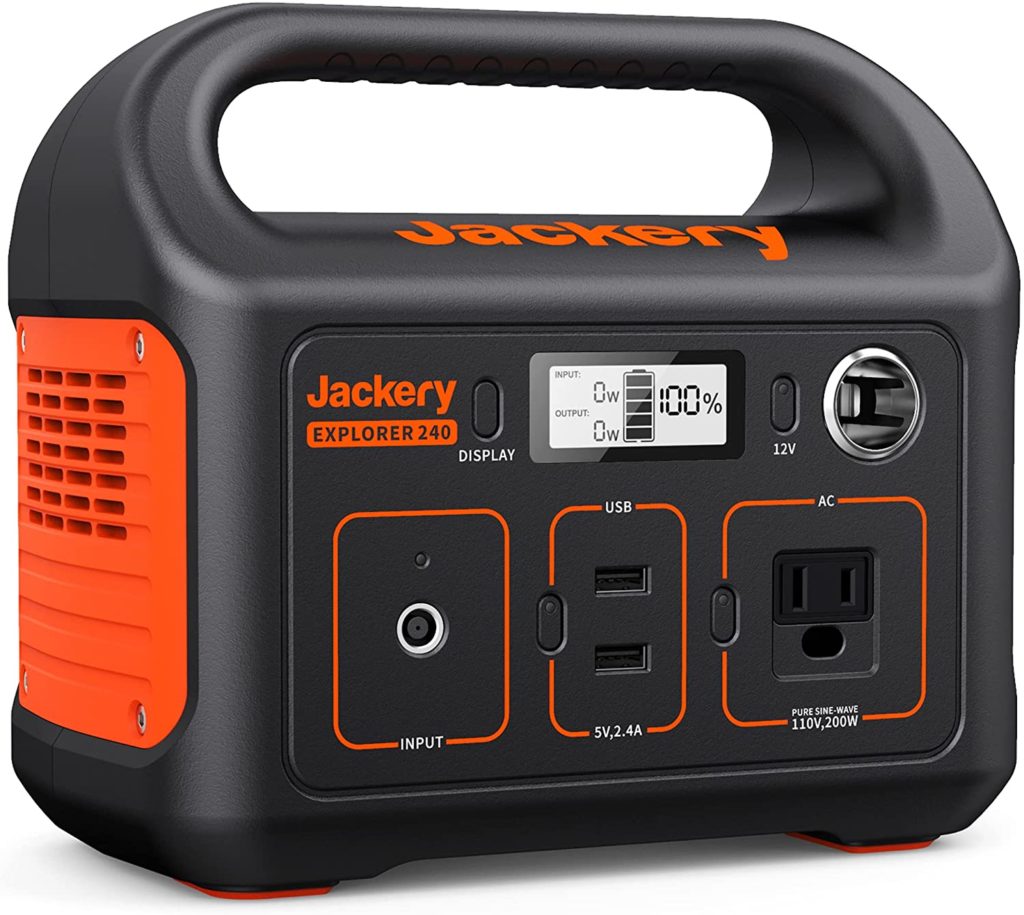Summary
This document provides a simplified user guide for the Jackery 240 battery power pack. [View/Buy] The full 16-page user guide in PDF format is also available. [View]
Understanding the Power Output Duration
The unit is rated as providing 240 watt hours of power. So, 200 watts for slightly over one hour. Or, 24 watts for ten hours. The watt hours rating refers to the length of time the power pack can provide power.
Important: Maximum Output Capacity
The power pack is rated to provide 200W maximum output at any one time. This is more than sufficient for small electronic devices such as smartphones, a laptop computer, or five 40 watt light bulbs. Any individual device or combination of devices up to 200 watts is okay.
The circuitry should prevent damage from an overload, but it’s best to be careful anyway. The power pack is NOT intended for high power household appliances such as microwave ovens, vacuum cleaners, laser printers, refrigerators, or heaters. For large appliances consider the Jackery 1000 which can handle a 1,000 watt load (for one hour). [View] Another high power unit would be the BLUETTI brand 2000 watt hour system. [View]
Overview of the Jackery 240
The following overview is based on the image shown below, with highlights featured from left to right, top to bottom.
- DISPLAY BUTTON — The display button will illuminate the display and result in the system information to appear. The light and display will turn off if there is no activity. If the ports are turned on and enabled, then the display readout will show, but the light will turn off to save power. Push the display button again to turn on the backlight.
- DISPLAY READOUT — The readout shows:
- INPUT — The wattage input while charging the battery. The input wattage will fluctuate depending on the source and charging status. Sources can be the AC adapter, a DC auto cigarette lighter cable adapter cord plugged into a car, or solar panels. You can charge the battery while devices are plugged into the power pack. If the input wattage is greater than the output wattage, the battery will continue to charge.
- OUTPUT — When a device is plugged into any of the power outlets, the total output wattage will be displayed.
- BATTERY — The battery icon provides a visual view of the battery level in five 20% increments.
- PERCENT — The percentage reading shows the battery level as a percentage of full capacity.
- 12V BUTTON — The 12V button enables and disables the 12-volt power port.
- 12V POWER PORT — Some devices designed to be used in cars might plug into a port like this one. It resembles an automobile power plug which is sometimes referred to as a cigarette lighter plug-in. Be careful not to put your finger in this port. Keep it turned off unless needed.
- INPUT PORT — The input port is used for charging the battery pack. As mentioned above, power sources for charging can be the AC adapter (included), the DC auto cigarette lighter cable adapter cord plugged into a car, or solar panels. You can charge the battery while devices are plugged into the power pack. A green light will illuminate above the plug when power is being received into the device.
- USB PORTS — The USB ports are enabled by pressing the button the left of the USB ports. When on, a green light on the button will illuminate. These ports provide 5 volts with 2.4 amp capacity. This is sufficient for charging most small electronics at a normal charging speed. Higher wattage charging for faster charging would require a dedicated charging adapter for 10 watt, 20 watt, or higher charging. That would plug into the AC port rather than a USB port.
- AC PORT — The AC port is rated as 110 volt and 200 watts maximum. It provides pure sine wave power, which means it can power delicate electronics and computer equipment without impeding reliable operation.
- AC POWER BUTTON — The AC power button is found to the left of the AC plug. This enables or disables the AC plug. When on, a green light will illuminate on the button.
- NOT GROUNDED — The AC plug port looks like it has a receptacle for the grounding pin on a three-prong power plug. The hole below the AC plug-in is provided to accommodate two-prong or three-prong plugs, but it does not serve any grounding purpose.
- FAN — When you first push the AC power button, after about 1-2 seconds you will hear a fan start and run for about 2 seconds. You may feel air exhaust from the right side of the power pack. This fan will turn back on if needed to cool down the power pack. This happens only when the power pack is under a significant power load.
- 5 WATT DRAIN — If you turn on the AC power port and have nothing plugged into it, you will notice the power pack is experiencing a 5 watt power drain showing in the display as 5 watts output. This is likely due to the power lost when inverting from DC voltage to 110 volts of AC power.

Additional Considerations
Here are some additional considerations.
- Online comments from Jackery owners state that the unit may turn itself off if it doesn’t sense a sufficient power demand. It will interpret this as not being in use, so it will turn off to conserve power. However, with the AC power outlet turned on, the Jackery displays 5 watts of power output even with nothing plugged in. It may be that this is a fantom power drain to simulate usage to avoid having the system go into sleep mode. This is just speculation and needs to be confirmed with Jackery.
- Only turn on the power features you are currently needing and using. Having ports on but not in use may result in a slight drain to the battery.
